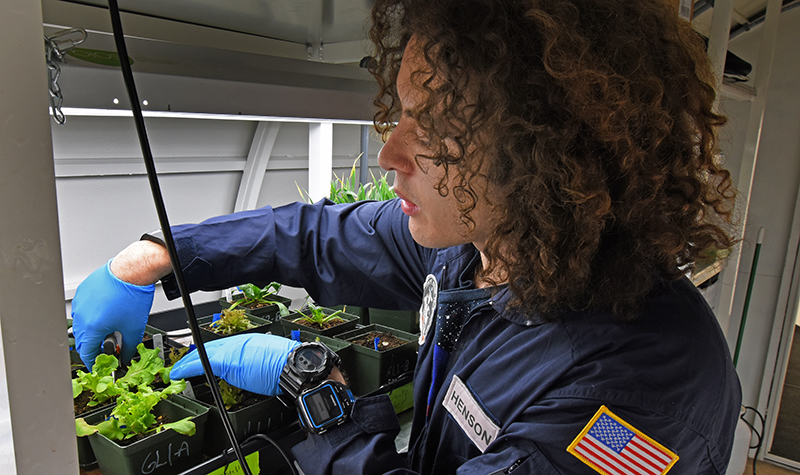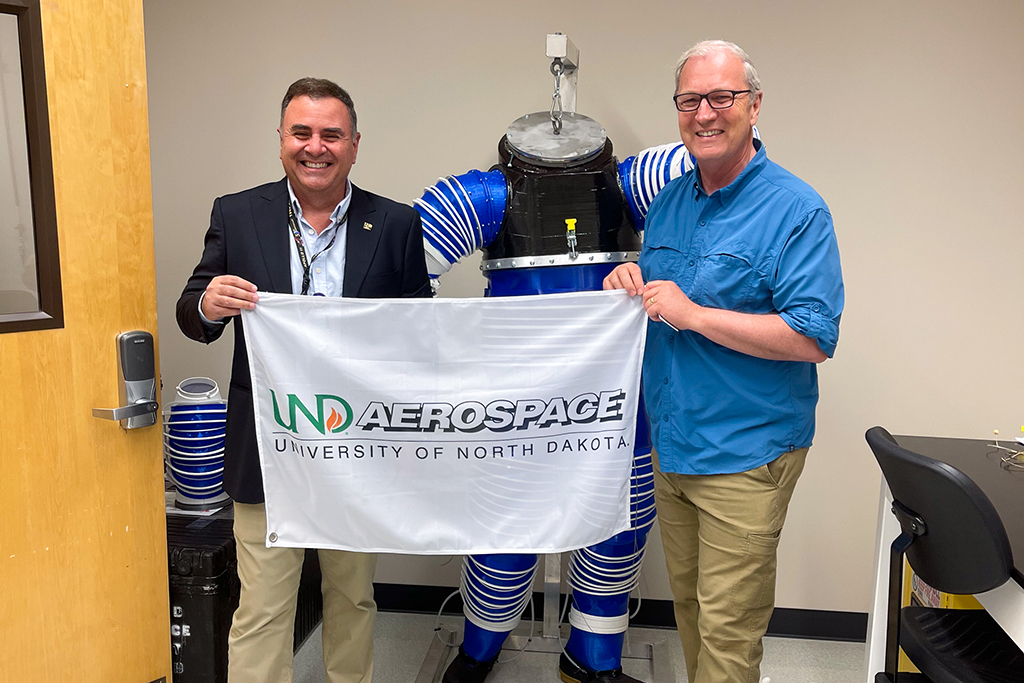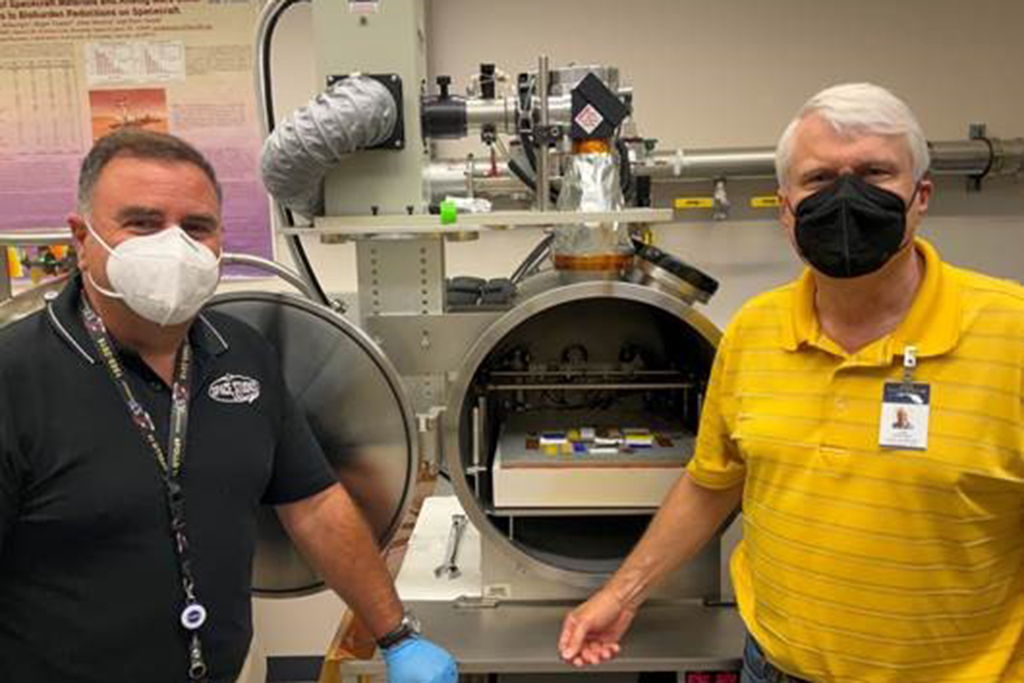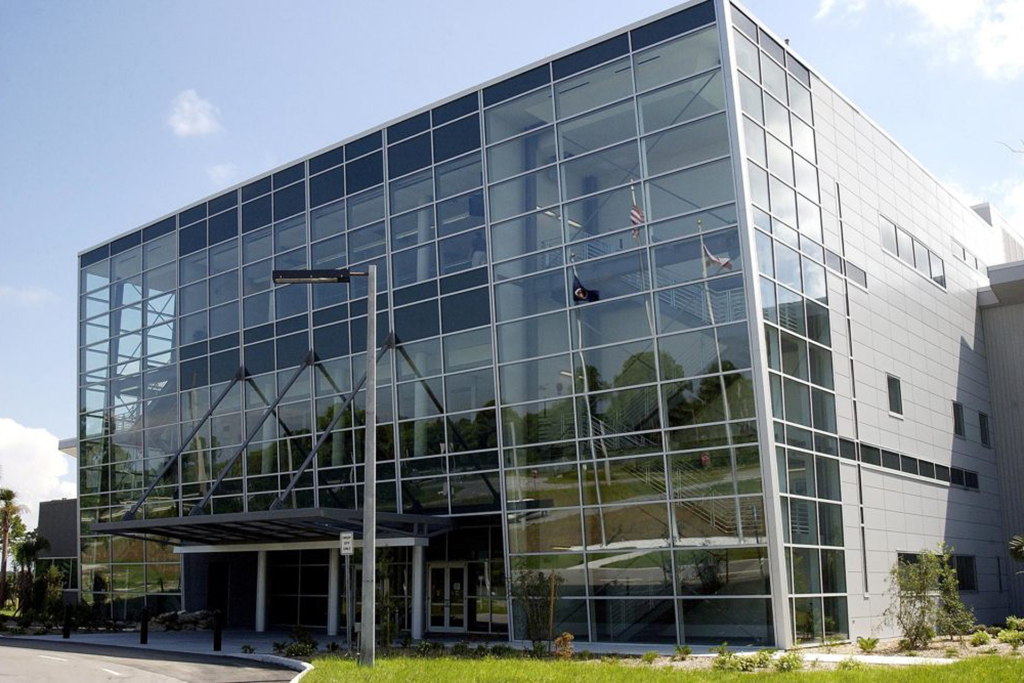A Florida outpost for UND
University’s Human Spaceflight Laboratory opens at NASA’s Kennedy Space Center

UND’s Space Studies department has a new lab, but you won’t be able to find it near the Human Spaceflight Laboratory in Clifford Hall on campus. Nor will you find it across the interstate, where the Inflatable Lunar/Mars Habitat is located.
Nor will you find it anywhere else in Grand Forks, or even North Dakota.
Instead, you’ll have to go nearly 2,000 miles south and east – to the Space Coast itself.
At NASA’s Kennedy Space Center, on Merritt Island, Fla., UND now has a lab all its own.
Space Studies has taken up residence in the Space Life Sciences Laboratory, a building in NASA’s Floridian hub.
The move was years in the making, and the hope is to maintain an official presence for years to come, said Pablo de León, professor, chair of the Space Studies Department and director of the Human Spaceflight Laboratory.
UND was on a two-year waitlist for the chance to occupy one of the more than 40 total labs in the Space Life Sciences building. Now that the wait is over, de León’s goal is to increase the number of internships available to students in his lab, thereby bringing both distance and on-campus students to Kennedy Space Center.
“We decided to go ahead with this because of the number of relationships we have developed with NASA and the closeness to the center of activities taking place,” de León said.
“This will increase the opportunities for our students to do NASA internships, and we intend to bring graduate students to the Kennedy Space Center on a regular basis to work on current and future projects.”
Moreover, this latest move has already proven its value – giving de León unprecedented access to equipment and resources as he works on what could potentially be the next generation of spacesuits.

For the past 10 years or so, Space Studies has conducted research in a way that’s created connections between UND and activities in the Space Life Sciences Lab.
Kennedy Space Center is NASA’s home for most of its nutrition and plant-related space research, according to de León. And at UND, there is an entire section of the Inflatable Lunar/Mars Habitat that’s dedicated to plant production.
“When we decided on that module, the experts at Kennedy Space Center were the ones who gave us the blueprints to make it happen,” de León remarked. “From the technical aspects of the lighting to the dimensions of the trays used for planting, we learned from them and worked closely to put it all together.”
Since the habitat’s assembly five years ago, the plant production module has played a role in nearly all of its missions. And in the Space Studies department, space agriculture has been an ongoing topic of interest and research.
Earlier this year, UND also hosted Grand Farm’s Space Ag Conference, which focused on the future of agriculture, both in space and on Earth. The conference provided opportunities for NASA and North Dakota-based researchers and businesses to interact and exchange ideas.
Factor in de León’s years of NASA-funded research, as well as UND’s extended history of NASA involvement, and the Human Spaceflight Laboratory annex starts to make sense.
“UND is a great place for our research, for a number of reasons,” de León said. “But UND is also far from any NASA center, which can work against us when trying to participate in projects. The creation of this lab annex widens our horizons in the number of projects and things we can work on.”

In the time since setting up shop in the Space Life Sciences Laboratory, de León has moved a number of the lab’s 3D printing machines from UND to Florida. The move started a new chapter in de León’s three-year, $750,000 project testing the viability of 3D-printed materials for space exploration.
Since late 2020, de León’s research on a 3D-printed spacesuit prototype has happened on campus, using multiple printers to transform plastics into flexible, durable materials that can withstand the stresses of space.
And given the limited space of the lab annex – a single, fully equipped room among dozens of others – work will still be happening at UND. But it’s the levels of access that come with the territory that are as important as the actual workspace.
Back in March, Sen. Kevin Cramer, R-N.D., visited the UND lab during a tour of Kennedy Space Center and saw the prototype first-hand. De León remarked that Cramer was the lab’s first “VIP visitor,” and that the senator was interested in how UND and NASA’s relationship has developed over time.
Also earlier this year, de León connected with a University of Florida researcher, Andrew Schuerger, who developed a Mars environmental chamber housed at Space Life Sciences. The small, pressurized chamber can replicate the surface conditions of Earth’s planetary neighbor, from atmosphere to temperature to radiation.
Schuerger originally developed the chamber to test biological specimens – to see how microbes can grow on Mars in cases of human contamination, for instance – but de León was intrigued by its potential versatility.
“I asked if we could test some of the materials and compare them with traditional spacesuit material, because we so far have no idea how compatible these new materials will be with the Martian environment,” de León said.
“There are still a number of unknowns with 3D-printed materials we’ve developed, such as how they react to drastic changes in temperature, and what gases they might release in those conditions.”

With Schuerger’s help, de León ran hours-long tests on spacesuit pieces. Over the next few months, mechanical engineering researchers at UND will test the differences between exposed materials and unaltered samples. Other data from the experiment will help de León answer questions of gasses released by the plastics.
“This is a key experiment, because it will help us see if this technology is worth exploring further, not just for spacesuits, but any applications in space that could use this material,” de León said. “What’s intriguing about all of this is the potential to manufacture objects at the destination, rather than on Earth.”
From de León’s perspective, this step in the project was possible because the two scientists worked in the same building. In other cases, the costs and logistics of using the equipment might have been prohibitive, and now de León can readily collaborate with geographically distant peer researchers.
“Over time, we’ll be able to increase and enhance the studies that we’re doing in the department and at the habitat because of what can only be done at Kennedy Space Center,” de León said. “The instruments we have are great, but we don’t have the millions of dollars in equipment that’s available at NASA.”

Amanda Ireland’s experience at the lab has also shown how UND’s new space can attract more Space Coast talent to the program. After all, the Space Life Sciences Laboratory is just down the road from her day job at Boeing.
As a launch operations engineer working on the Starliner mission, Ireland was looking for a part-time, distance Ph.D. opportunity. UND was on the shortlist, and de León was highly recommended by some of her UND alumni colleagues, but it was the fact that UND had a local lab that pushed her to start taking classes online and apply for a Ph.D. program spot starting this fall.

“There were a number of things exposing me to the work happening at UND, in Dr. de León’s lab, and I was impressed and thought it was a good fit,” Ireland said. “It’s super convenient for me, as a part-time student, to go to work in the morning then go to the lab afterward. It’s right on my way home.”
This summer, she’s been able to access the lab annex to work on a project for one of her UND Space Studies courses.
Ireland is studying how to control a custom lighting system that NASA gave to the University, which is a far cry from your everyday fixture-and-bulb. According to de León, NASA designed the lights specifically for use on the International Space Station. It’s possible to change the color and temperature, among other adjustments. The idea behind the system was to have different effects on crew members living in space for months on end.
As this lighting system is installed at UND, in the Inflatable Lunar/Mars Habitat, Ireland is working on a software interface that can help UND’s crews meet the needs of their missions and harness the advanced technology.
“What’s cool is that, while this was developed for space use, it has the right scale for the ILMH at UND,” Ireland said. “And we’re really interested by the color tuning of the system. When you’re in an environment that doesn’t have normal circadian inputs, that kind of light can become really important.”
And as someone with experience in the industry, as well as a daily commute through the country’s most iconic spaceport, Ireland has a good sense for what’s waiting for future students.
“I’ve been here for three and a half years, and you’re exposed to so many different networks in the industry that will help you in your career,” she said. “And at the lab, you’re surrounded by people working toward shared goals and missions, and it really motivates you in your work.”



